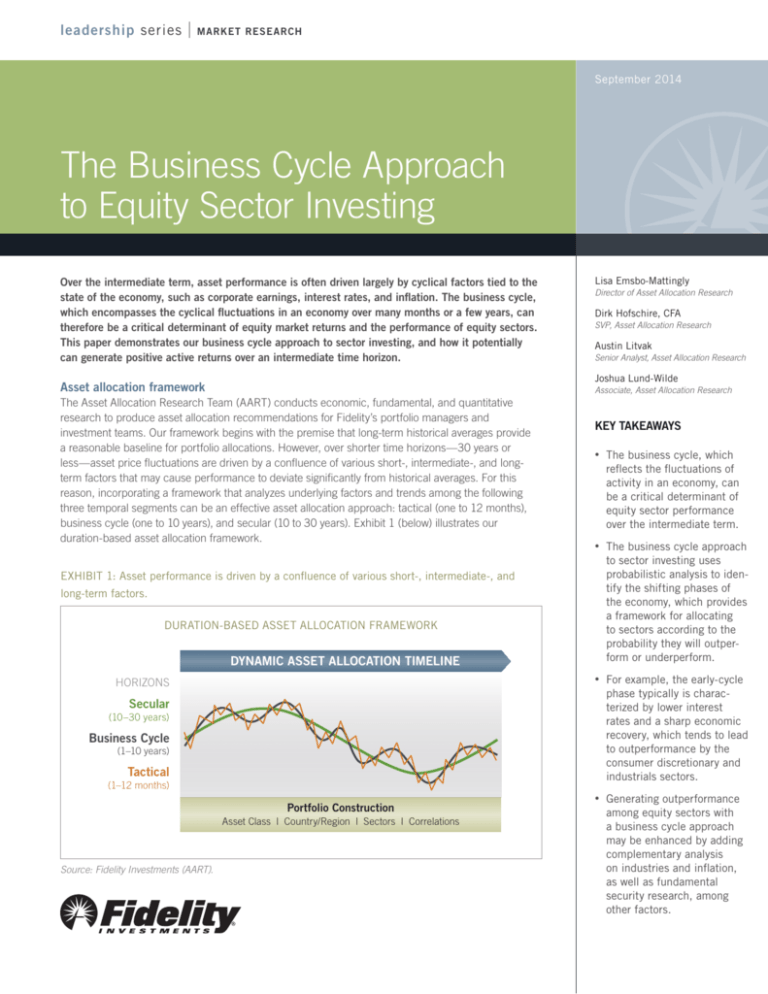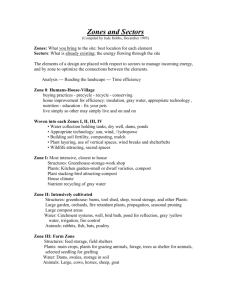
leadership series
MARKET RESE ARCH
September 2014
The Business Cycle Approach
to Equity Sector Investing
Over the intermediate term, asset performance is often driven largely by cyclical factors tied to the
state of the economy, such as corporate earnings, interest rates, and inflation. The business cycle,
which encompasses the cyclical fluctuations in an economy over many months or a few years, can
therefore be a critical determinant of equity market returns and the performance of equity sectors.
This paper demonstrates our business cycle approach to sector investing, and how it potentially
can generate positive active returns over an intermediate time horizon.
Lisa Emsbo-Mattingly
Director of Asset Allocation Research
Dirk Hofschire, CFA
SVP, Asset Allocation Research
Austin Litvak
Senior Analyst, Asset Allocation Research
Joshua Lund-Wilde
Asset allocation framework
The Asset Allocation Research Team (AART) conducts economic, fundamental, and quantitative
research to produce asset allocation recommendations for Fidelity’s portfolio managers and
investment teams. Our framework begins with the premise that long-term historical averages provide
a reasonable baseline for portfolio allocations. However, over shorter time horizons—30 years or
less—asset price fluctuations are driven by a confluence of various short-, intermediate-, and longterm factors that may cause performance to deviate significantly from historical averages. For this
reason, incorporating a framework that analyzes underlying factors and trends among the following
three temporal segments can be an effective asset allocation approach: tactical (one to 12 months),
business cycle (one to 10 years), and secular (10 to 30 years). Exhibit 1 (below) illustrates our
duration-based asset allocation framework.
Associate, Asset Allocation Research
KEY TAKEAWAYS
•
The business cycle, which
reflects the fluctuations of
activity in an economy, can
be a critical determinant of
equity sector performance
over the intermediate term.
•
The business cycle approach
to sector investing uses
probabilistic analysis to identify the shifting phases of
the economy, which provides
a framework for allocating
to sectors according to the
probability they will outperform or underperform.
•
For example, the early-cycle
phase typically is characterized by lower interest
rates and a sharp economic
recovery, which tends to lead
to outperformance by the
consumer discretionary and
industrials sectors.
•
Generating outperformance
among equity sectors with
a business cycle approach
may be enhanced by adding
complementary analysis
on industries and inflation,
as well as fundamental
security research, among
other factors.
EXHIBIT 1: Asset performance is driven by a confluence of various short-, intermediate-, and
long-term factors.
DURATION-BASED ASSET ALLOCATION FRAMEWORK
DYNAMIC ASSET ALLOCATION TIMELINE
HORIZONS
Secular
(10–30 years)
Business Cycle
(1–10 years)
Tactical
(1–12 months)
Portfolio Construction
Asset Class l Country/Region l Sectors l Correlations
Source: Fidelity Investments (AART).
Understanding business cycle phases
nomic activity (e.g., gross domestic product, industrial production), then an accelerating growth rate. Credit conditions stop
tightening amid easy monetary policy, creating a healthy environment for rapid margin expansion and profit growth. Business
inventories are low, while sales growth improves significantly.
Every business cycle is different in its own way, but certain
patterns have tended to repeat themselves over time. Fluctuations in the business cycle are essentially distinct changes in the
rate of growth in economic activity, particularly changes in three
key cycles—the corporate profit cycle, the credit cycle, and the
inventory cycle—as well as changes in the employment backdrop
and monetary policy. While unforeseen macroeconomic events
or shocks can sometimes disrupt a trend, changes in these key
indicators historically have provided a relatively reliable guide
to recognizing the different phases of an economic cycle. Our
quantitatively backed, probabilistic approach helps in identifying,
with a reasonable degree of confidence, the state of the business
cycle at different points in time. Specifically, there are four distinct
phases of a typical business cycle (see Exhibit 2, below).
•
Early-cycle phase: Generally, a sharp recovery from recession,
marked by an inflection from negative to positive growth in eco-
•
Mid-cycle phase: Typically the longest phase of the business
cycle. The mid-cycle is characterized by a positive but more
moderate rate of growth than that experienced during the
early-cycle phase. Economic activity gathers momentum, credit
growth becomes strong, and profitability is healthy against an
accommodative—though increasingly neutral—monetary policy
backdrop. Inventories and sales grow, reaching equilibrium relative to each other.
•
Late-cycle phase: Emblematic of an “overheated” economy
poised to slip into recession and hindered by above-trend rates
of inflation. Economic growth rates slow to “stall speed” against
EXHIBIT 2: The business cycle has four distinct phases, with the example of the U.S. in a mid-cycle expansion in mid-2014.
TYPICAL BUSINESS CYCLE
Inflationary Pressures
Red = High
EARLY
•
•
•
•
•
MID
Activity rebounds
(GDP, IP, incomes)
Credit begins to grow
Profits grow rapidly
Policy still stimulative
Inventories low;
sales improve
•
•
•
•
•
LATE
Growth peaking
Credit growth strong
Profit growth peaks
Policy neutral
Inventories, sales grow;
equilibrium reached
•
•
•
•
•
Growth moderating
Credit tightens
Earnings under pressure
Policy contractionary
Inventories grow;
sales growth falls
RECESSION
•
•
•
•
•
Falling activity
Credit dries up
Profits decline
Policy eases
Inventories, sales fall
U.S.
RECOVERY
EXPANSION
CONTRACTION
+
Economic Growth
–
Relative Performance
of Economically
Sensitive Assets
Green = Strong
Note: This is a hypothetical illustration of a typical business cycle. There is not always a chronological progression in this order, and there have been cycles
when the economy has skipped a phase or retraced an earlier one. Economically sensitive assets include stocks and high-yield corporate bonds, while less
economically sensitive assets include Treasury bonds and cash. Please see the endnotes for a complete discussion. Source: Fidelity Investments (AART).
2
a backdrop of restrictive monetary policy, tightening credit availability, and deteriorating corporate profit margins. Inventories
tend to build unexpectedly as sales growth declines.
•
Recession phase: Features a contraction in economic activity.
Corporate profits decline and credit is scarce for all economic
actors. Monetary policy becomes more accommodative and
inventories gradually fall despite low sales levels, setting up for
the next recovery.
The performance of economically sensitive assets such as stocks
tends to be the strongest during the early phase of the business
cycle when growth is rising at an accelerating rate, then moderates
through the other phases until returns generally decline during the
recession. In contrast, more defensive assets such as Treasury
bonds typically experience the opposite pattern, enjoying their
highest returns relative to stocks during a recession and their worst
performance during the early cycle (see Leadership Series article
“The Business Cycle Approach to Asset Allocation,” Sep. 2014).
Equity sector performance patterns
Historical analysis of the cycles since 1962 shows that the relative
performance of equity market sectors has tended to rotate as the
overall economy shifts from one stage of the business cycle to
the next, with different sectors assuming performance leadership
in different economic phases1 (see “Analyzing relative sector
performance, right). Due to structural shifts in the economy,
EXHIBIT 3: Sectors that have tended to perform well in the
early cycle are those that are interest-rate sensitive (consumer
discretionary and financials) and economically sensitive
(industrials and information technology).
Analyzing relative sector performance
Certain metrics help evaluate the historical performance of
each sector relative to the broader equity market (all data are
annualized for comparison purposes):
•
Full-phase average performance: Calculates the (geometric)
average performance of a sector in a particular phase of the
business cycle and subtracts the performance of the broader
equity market. This method better captures the impact of
compounding and performance that is experienced across
full market cycles (i.e., longer holding periods). However, performance outliers carry greater weight and can skew results.
•
Median monthly difference: Calculates the difference in the
monthly performance of a sector compared with the broader
equity market, and then takes the midpoint of those observations. This measure is indifferent to when a return period
begins during a phase, which makes it a good measure for
investors who may miss significant portions of each business
cycle phase. This method mutes the extreme performance
differences of outliers, and also underemphasizes the impact
of compounding returns.
•
Cycle hit rate: Calculates the frequency of a sector’s outperforming the broader equity market over each business cycle
phase since 1962. This measure represents the consistency
of sector performance relative to the broader market over
different cycles, removing the possibility that outsized gains
during one period in history influence overall averages. This
method suffers somewhat from small sample sizes, with only
seven full cycles during the period, but persistent out- or
underperformance still can be observed.
Median Monthly Difference
Hit Rate
100%
10%
0%
60%
–5%
40%
–10%
Cycle Hit Rate
80%
5%
20%
–15%
Telecom
Utilities
Energy
Health Care
Cons. Staples
Financials
Materials
Industrials
Info. Tech.
0%
–20%
Cons. Disc.
Annualized Relative Performance
EARLY CYCLE
Full-Phase Average
15%
Source: Fidelity Investments (AART) as of Jul. 31, 2014. Past performance
is no guarantee of future results.
3
technological innovation, varying regulatory backdrops, and other
factors, no one sector has behaved uniformly for every business
cycle. While it is important to note outperformance, it is also
helpful to recognize sectors with consistent underperformance.
Knowing which sectors of the market to avoid can be just as useful
as knowing which tend to have the most robust outperformance.
Early-cycle phase
Historically the phase of the business cycle with the most robust
performance, the early-cycle phase has tended to feature positive
absolute performance. Since 1962, the broader stock market
has produced an average total return of more than 20% per year
during this phase, and its average length has been roughly one
year. On a relative basis, sectors that typically benefit most from
a backdrop of low interest rates and the first signs of economic
improvement have tended to lead the broader market’s advance.
Specifically, interest-rate-sensitive sectors—such as consumer
discretionary and financials—historically have outperformed
the broader market (see Exhibit 3, page 3). These sectors have
performed well, due in part to industries within the sectors that
typically benefit from increased borrowing, including diversified
financials and consumer-linked industries such as autos and
household durables in consumer discretionary.
Elsewhere, economically sensitive sectors—such as information
technology and industrials—have been boosted by shifts
from recession to recovery. For example, the industrials sector
has some industries—such as transportation—in which stock
prices often have rallied in anticipation of economic recovery.
Tech stocks typically have been aided by renewed expectations
for consumer and corporate spending strength, boosting the
prospects of industries such as semiconductors.
Laggards of the early-cycle phase include telecommunication
services and utilities, which generally are more defensive in
nature due to fairly persistent demand across all stages of the
cycle. Energy sector stocks also have lagged during the early
phase, as inflationary pressures—and thus energy prices—tend
to be lower during a recovery from recession. Each of these three
sectors has failed to outperform the market in every early-cycle
phase since 1962. From a performance consistency perspective,
consumer discretionary stocks have beaten the broader market
in every early-cycle phase since 1962, while industrials also
have exhibited impressive cycle hit rates. The financials and
information technology sectors both have had healthy average
and median relative performance, though their low hit rates are
due in part to the diversity of their underlying industries.
Mid-cycle phase
As the economy moves beyond its initial stage of recovery
and as growth rates moderate, the leadership of interest-ratesensitive sectors typically has tapered. At this point in the cycle,
economically sensitive sectors still have performed well, but
a shift has often taken place toward some industries that see
a peak in demand for their products or services only after the
expansion has become more firmly entrenched. Average annual
stock market performance has tended to be fairly strong (roughly
15%), though not to the same degree as in the early-cycle phase.
In addition, the average mid-cycle phase of the business cycle
tends to be significantly longer than any other stage (roughly
three-and-a-half years), and this phase is also when most stock
market corrections have taken place. For this reason, sector
leadership has rotated frequently, resulting in the smallest sector
performance differentiation of any business cycle phase. No
sector has outperformed or underperformed the broader market
more than three-quarters of the time, and the magnitude of the
relative performance has been modest compared with the other
three phases.
Information technology has been the best performer of all the
sectors during this phase, having certain industries—such as
software and hardware—that typically pick up momentum once
companies gain more confidence in the stability of an economic
recovery and are more willing to make capital expenditures (see
Exhibit 4, below left).
EXHIBIT 5: As the economic recovery matures, the energy and
EXHIBIT 4: Sector leadership has rotated frequently in the
materials sectors, whose fate is closely tied to the prices of raw
mid-cycle phase, resulting in the smallest sector performance
materials, have typically performed well, as have defensive-
differentiation of any business cycle phase.
oriented sectors (health care, consumer staples, and utilities).
Source: Fidelity Investments (AART) as of Jul. 31, 2014.
Cons. Disc.
Info. Tech.
Materials
Utilities
Cons. Staples
Cons. Disc.
Financials
Health Care
Industirals
Telecom
Energy
0%
–10%
Telecom
0%
–5%
20%
–5%
Industrials
20%
–4%
Cycle Hit Rate
40%
0%
Financials
–3%
60%
5%
Utilities
40%
80%
Cons. Staples
–1%
–2%
Hit Rate
100%
10%
Materials
60%
Median Monthly Difference
15%
Health Care
1%
0%
Cycle Hit Rate
80%
Full-Phase Average
20%
Energy
3%
Source: Fidelity Investments (AART) as of Jul. 31, 2014.
4
Hit Rate
100%
Annualized Relative Performance
LATE CYCLE
Median Monthly Difference
2%
Info. Tech.
Annualized Relative Performance
MID CYCLE
Full-Phase Average
4%
The industrials sector has lacked consistent outperformance,
but contains industries that are well suited for a mid-cycle expansion. For example, capital goods producers tend to benefit from
the pickup in demand in an environment of sustained and more
predictable economic growth. From an underperformance perspective, the utilities and materials sectors have lagged by the greatest
magnitude. Due to the lack of clear sector leadership, the mid-cycle
phase is a market environment in which investors may want to
consider keeping their sector bets to a minimum while employing
other approaches to generate additional active opportunities (see
“Additional considerations for capturing alpha in sectors,” page 6).
Late-cycle phase
The late-cycle phase has had an average duration of roughly
a year and a half, and overall stock market performance has
averaged a little over 5% on an annualized basis. As the economic
recovery matures, the energy and materials sectors, whose fate
is closely tied to the prices of raw materials, previously have done
well as inflationary pressures build and the late-cycle economic
expansion helps maintain solid demand (see Exhibit 5, page 4).
Elsewhere, as investors begin to glimpse signs of an economic
slowdown, defensive-oriented sectors—those in which revenues
are tied more to basic needs and are less economically sensitive,
particularly health care, but also consumer staples and utilities—
generally have performed well. Looking across all three analytical
measures, the energy sector has seen the most convincing
patterns of outperformance in the late cycle, with high average
and median relative performance along with a high cycle hit rate.
EXHIBIT 6: Defensive-oriented sectors (consumer staples,
utilities, telecommunication services, and health care) have
tended to outperform during the recession phase.
Full-Phase Average
20%
Median Monthly Difference
10%
60%
5%
40%
0%
20%
–5%
0%
Info. Tech.
Industrials
Financials
Materials
Cons. Disc.
Energy
Health Care
Telecom
Utilities
–10%
Cycle Hit Rate
80%
Source: Fidelity Investments (AART) as of Jul. 31, 2014.
5
Hit Rate
100%
15%
Cons. Staples
Annualized Relative Performance
RECESSION CYCLE
EXHIBIT 7: Equity sector relative performance has tended to be
differentiated across business cycle phases.
Sector
Early
Financials
+
++
+
++
Consumer Discretionary
Technology
Industrials
Materials
Consumer Staples
Health Care
Energy
Telecom
Utilities
−
−
−−
−−
−−
Mid
Late
Recession
−
+
+
−−
−
−−
−−
++
+
++
++
+
−−
−−
−
++
++
++
++
Unshaded (white) portions above suggest no clear pattern of over- or underperformance vs. broader market. Double +/– signs indicate that the sector is
showing a consistent signal across all three metrics: full-phase average performance, median monthly difference, and cycle hit rate. A single +/– indicates
a mixed or less consistent signal. Source: Fidelity Investments (AART).
Information technology and consumer discretionary stocks have
lagged most often, tending to suffer the most during this phase
as inflationary pressures crimp profit margins and investors move
away from the most economically sensitive areas.
Recession phase
The recession phase has historically been the shortest, lasting
slightly less than a year on average—and the broader market
has performed poorly during this phase (roughly –15% average
annual return). As economic growth stalls and contracts, sectors
that are more economically sensitive fall out of favor and those
that are defensively oriented move to the front of the performance
line. These less economically sensitive sectors, including
consumer staples, utilities, telecommunication services, and
health care, are dominated by industries that produce items
such as toothpaste, electricity, phone service, and prescription
drugs, which consumers are less likely to cut back on during a
recession (see Exhibit 6, left). These sectors’ profits are likely to
be more stable than those in other sectors during a contracting
economy. The consumer staples sector has a perfect track
record of outperforming the broader market throughout the entire
recession phase, while utilities, telecommunications services,
and health care are frequent outperformers. High dividend yields
provided by utility and telecom companies also have helped
these two sectors hold up relatively well during recessions. On
the downside, economically and interest-rate-sensitive sectors—
such as industrials, information technology, materials, and
financials—typically have underperformed the broader market
during this phase.
The merits of the business cycle approach
EXHIBIT 9: Certain sectors, such as information technology,
The business cycle approach offers considerable potential for
taking advantage of relative sector performance opportunities.
As the probability of a shift in phase increases—for instance,
from mid cycle to late cycle—such a strategy allows investors to
adjust their exposure to sectors that have prominent performance
patterns in the next phase of the cycle (see Exhibit 7, page 5). Our
views on these phase shifts are presented in recurring monthly
updates on the business cycle.2 By its very nature, the business
cycle focuses on an intermediate time horizon (i.e., cycle phases
that rotate on average every few months to few years). This may
make it more practical for some investors to execute than shorterterm approaches.
materials, and energy, tend to generate a greater percentage of
their revenues abroad.
SECTORS’ FOREIGN SALES EXPOSURE
Info. Tech.
Materials
Energy
Cons. Staples
Industrials
Health Care
Cons. Disc.
Additional considerations for capturing alpha in sectors
Incorporating analysis and execution at the industry level may
provide investors with greater opportunities to generate relative
outperformance (“alpha”) in a business cycle approach. Industries
within each sector can have significantly different fundamental
performance drivers that may be masked by sector-level results,
leading to significantly different industry-level price performance
(see Exhibit 8, below). For example, during the early cycle—the
phase with the most differentiated sector performance—the
difference between the average relative returns of the best- and
worst-performing sectors since 1981 was roughly 25 percentage
points, whereas the relative performance differential at the
industry level was roughly 75 percentage points.3
In addition, there are other strategies that can be incorporated to
complement the business cycle approach and potentially capture
additional alpha in equity sectors. Consider the following:
•
Macro-fundamental analysis: Macro-fundamental industry
research can identify—independently of typical business cycle
patterns—variables specific to the dynamics of each industry
that may affect performance. For example, a significant change
Financials
Utilities
Telecom
0%
Average, market capitalization–weighted foreign sales as a percentage of
the total for Russell 1000® Index sectors. Data complete through 2012,
with two-thirds of companies reporting data for 2013. Source: FactSet,
Fidelity Investments (AART), as of Jul. 31, 2014.
in the cost of key raw material inputs can drive a deviation in
an industry’s performance—such as oil prices for airlines.
•
Bottom-up analysis: Company-specific analysis—through
individual security selection—can identify unique traits in
individual companies that may outweigh the impact of the
typical business cycle pattern on that company’s future
performance.
•
Global business-cycle analysis: The U.S. stock market has
global exposure, which may warrant allocating toward or
away from domestically focused sectors depending on the
phase of the U.S. business cycle relative to the rest of the
world. When the U.S. business cycle is more favorable than
the global cycle, sectors with more global exposure are likely
to face greater headwinds to revenue growth, while more
domestically linked sectors could fare relatively well. When
the 10 equity market sectors are ranked by their exposure to
foreign revenues, information technology comes out on top
and telecommunication services lands at the bottom (see
Exhibit 9, above).
•
Inflation overlay: The inflation backdrop can heavily
influence some sectors’ profitability. Short-term inflation
trends tend to ebb and flow with the movement of the
business cycle, but longer-term inflation trends sometimes
move independently of the business cycle. Of particular
importance is whether producer prices are rising more
EXHIBIT 8: Each industry within a sector has specific drivers
UNDERPERFORM
OUTPERFORM
that may affect performance.
EARLY
MID
LATE
RECESSION
Economically
and Interest
Rate
Sensitive
Economically
Sensitive
Defensive
and Inflation
Sensitive
Defensive
Defensive
Defensive
Source: Fidelity Investments (AART).
6
Economically
Sensitive
Economically
Sensitive
10% 20% 30% 40% 50% 60% 70%
quickly than consumer prices, and thus affecting profit
margins negatively, or vice versa.
•
•
Secular overlay: Long-term secular trends that are expected to
unfold over multiple business cycles can warrant a permanently
higher or lower allocation to a given sector than a pure business
cycle approach would suggest.
Tactical and quantitative strategies: Other short-term factors
may include sector volatility, price momentum, or the implementation of new tax policies.
Investment implications
Every business cycle is different, and so are the relative
performance patterns among equity sectors. However, using a
disciplined business cycle approach, it is possible to identify key
phases in the economy, and to use those signals in an effort to
achieve active returns from sector allocation.
Authors
Lisa Emsbo-Mattingly
Dirk Hofschire, CFA
Austin Litvak
Joshua Lund-Wilde
Director of Asset Allocation Research
SVP, Asset Allocation Research
Senior Analyst, Asset Allocation Research
Associate, Asset Allocation Research
The Asset Allocation Research Team (AART) conducts economic, fundamental, and quantitative research to develop asset allocation
recommendations for Fidelity’s portfolio managers and investment teams. AART is responsible for analyzing and synthesizing
investment perspectives across Fidelity’s asset management unit to generate insights on macroeconomic and financial market trends
and their implications for asset allocation.
7
Views expressed are as of the date indicated, based on the information
available at that time, and may change based on market or other
conditions. Unless otherwise noted, the opinions provided are those
of the authors and not necessarily those of Fidelity Investments or
its affiliates. Fidelity does not assume any duty to update any of the
information.
Past performance is no guarantee of future results.
Neither asset allocation nor diversification ensures a profit or
guarantees against a loss.
Investing involves risk, including risk of loss.
Stock markets are volatile and can decline significantly in response to
adverse issuer, political, regulatory, market, or economic developments.
Because of its narrow focus, sector investing tends to be more volatile
than investments that diversify across many sectors and companies.
Each sector investment is also subject to the additional risks associated
with its particular industry.
References to specific investment themes are for illustrative purposes
only and should not be construed as recommendations or investment
advice. Investment decisions should be based on an individual’s own
goals, time horizon, and tolerance for risk.
All indexes are unmanaged. You cannot invest directly in an index.
The Typical Business Cycle depicts the general pattern of economic cycles
throughout history, though each cycle is different. In general, the typical
business cycle demonstrates the following:
• During the typical early-cycle phase, the economy bottoms and picks
up steam until it exits recession and then begins the recovery as activity
accelerates. Inflationary pressures are typically low, monetary policy is
accommodative, and the yield curve is steep.
• During the typical mid-cycle phase, the economy exits recovery and
enters into expansion, characterized by broader and more self-sustaining
economic momentum but a more moderate pace of growth. Inflationary
pressures typically begin to rise, monetary policy becomes tighter, and the
yield curve experiences some flattening.
• During the typical late-cycle phase, the economic expansion matures,
inflationary pressures continue to rise, and the yield curve may eventually
become flat or inverted. Eventually, the economy contracts and enters
recession, with monetary policy shifting from tightening to easing.
Please note that there is no uniformity of time among phases, nor is there
always a chronological progression in this order. For example, business
cycles have varied between one and 10 years in the U.S., and there have
been examples when the economy has skipped a phase or retraced an
earlier one.
Endnotes
1
Source: Fidelity Investments (AART), as of Jul. 31, 2014.
See the latest monthly “Business Cycle Update,” Fidelity Investments
(AART), for a complete discussion of current trends.
2
3
Source: Fidelity Investments (AART), as of Jul. 31, 2014.
Index definitions
The S&P 500 ® Index is a market capitalization–weighted index of 500
common stocks chosen for market size, liquidity, and industry group
representation to represent U.S. equity performance. S&P 500 is a
registered service mark of Standard & Poor’s Financial Services LLC.
8
The Russell 1000 ® Index is a stock market index that represents
the highest-ranking 1,000 stocks in the Russell 3000 ® Index, which
represents about 90% of the total market capitalization of that index.
Sectors and industries are defined by the Global Industry Classification
Standard (GICS®). The S&P 500 Sector Indices include the 10
standard GICS® sectors that make up the S&P 500 ® Index. The market
capitalization of all 10 S&P 500 Sector Indices together compose the
market capitalization of the parent S&P 500 ® Index; all members of the
S&P 500 ® Index are assigned to one (and only one) sector.
S&P 500 sectors are defined as follows: Consumer Discretionary:
companies that provide goods and services that people want but don’t
necessarily need, such as televisions, cars, and sporting goods; these
businesses tend to be the most sensitive to economic cycles. Consumer
Staples: companies that provide goods and services that people use on
a daily basis, like food, household products, and personal-care products;
these businesses tend to be less sensitive to economic cycles. Energy:
companies whose businesses are dominated by either of the following
activities: the construction or provision of oil rigs, drilling equipment, or
other energy-related services and equipment, including seismic data
collection; or the exploration, production, marketing, refining, and/
or transportation of oil and gas products, coal, and consumable fuels.
Financials: companies involved in activities such as banking, consumer
finance, investment banking and brokerage, asset management,
insurance and investments, and real estate, including REITs. Health
Care: companies in two main industry groups: health care equipment
suppliers and manufacturers, and providers of health care services;
and companies involved in the research, development, production, and
marketing of pharmaceuticals and biotechnology products. Industrials:
companies whose businesses manufacture and distribute capital goods,
provide commercial services and supplies, or provide transportation
services. Information Technology: companies in technology software and
services and technology hardware and equipment. Materials: companies
that are engaged in a wide range of commodity-related manufacturing.
Telecommunication Services: companies that provide communications
services primarily through fixed-line, cellular, wireless, high bandwidth,
and/or fiber-optic cable networks. Utilities: companies considered to be
electric, gas, or water utilities, or companies that operate as independent
producers and/or distributors of power.
Third-party marks are the property of their respective owners; all other
marks are the property of FMR LLC.
If receiving this piece through your relationship with Fidelity Financial
Advisor Solutions (FFAS), this publication is provided to investment
professionals, plan sponsors, institutional investors, and individual
investors by Fidelity Investments Institutional Services Company, Inc.
If receiving this piece through your relationship with Fidelity Personal
& Workplace Investing (PWI), Fidelity Family Office Services (FFOS), or
Fidelity Institutional Wealth Services (IWS), this publication is provided
through Fidelity Brokerage Services LLC, Member NYSE, SIPC.
If receiving this piece through your relationship with National Financial
or Fidelity Capital Markets, this publication is FOR INSTITUTIONAL
INVESTOR USE ONLY. Clearing and custody services are provided
through National Financial Services LLC, Member NYSE, SIPC.
614169.15.0
© 2014 FMR LLC. All rights reserved.









